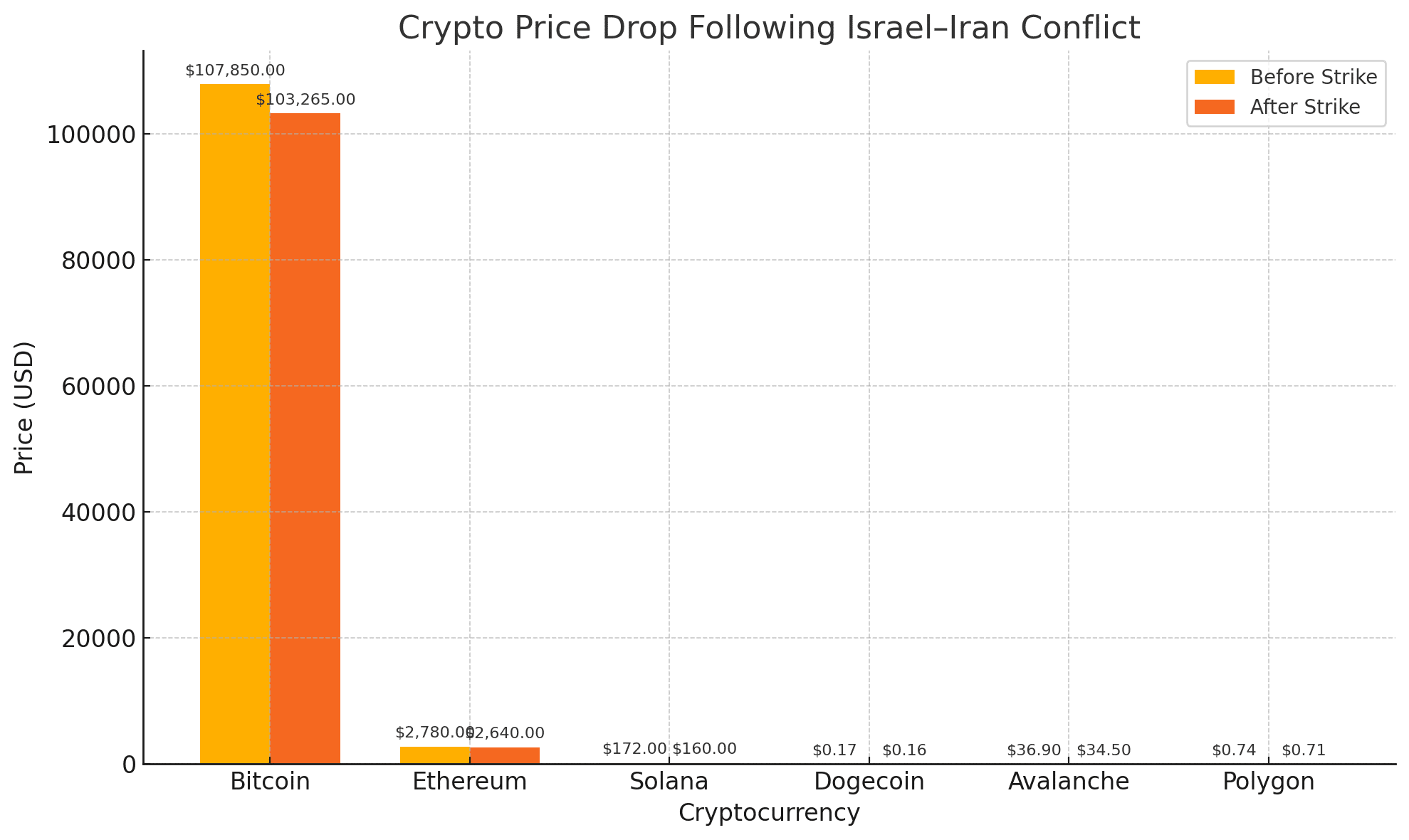The crypto market faced one of its most brutal shakeups of 2025 after Israel launched a surprise wave of airstrikes on Iran, targeting key military and nuclear sites in Tehran and Tabriz. The military action, confirmed by multiple international outlets, triggered widespread market panic, and Bitcoin led the collapse.
- Bitcoin Price Movement Before and After the Attack
- Altcoin Avalanche: ETH, SOL, DOGE Slammed
- Risk-Off Mode: Safe Havens Surge
- Analysis: Is Bitcoin Still a Safe Haven?
- Operation Rising Lion: What We Know
- What to Watch This Week
- Final Thoughts: Fear, Flight, and Fragility
- FAQs
- Why did Bitcoin drop below $103K?
- Which altcoins were most affected by the crash?
- Is Bitcoin still considered a safe haven?
- Will crypto markets recover soon?
- Glossary of Key Terms
In under 12 hours, BTC plunged over 4.5%, crashing below $103,000, while altcoins like Ethereum (ETH), Solana (SOL), Dogecoin (DOGE), Avalanche (AVAX), and Polygon (MATIC) followed in synchronized decline.
Bitcoin Price Movement Before and After the Attack
| Date | BTC Price (USD) | Change | Event |
|---|---|---|---|
| June 12, 2025 | $107,850 | — | Stable trading pre-airstrike |
| June 13, 2025 | $103,265 | –4.26% | Israel strikes Iran confirmed |
| Intraday Low | $102,900 | –4.6% | Liquidations intensify |
| Recovery Point | $104,100 | +1.2% off low | Temporary rebound |
More than $550 million in long BTC positions were liquidated, according to CoinGlass data. The market reacted not just emotionally but mechanically, triggering stop losses, margin calls, and automated sell-offs across derivatives platforms.
Altcoin Avalanche: ETH, SOL, DOGE Slammed
The war-induced volatility wasn’t confined to Bitcoin. Altcoins suffered across the board, with Ethereum, Solana, and meme coins taking especially hard hits.
| Coin | Price (USD) | 24h % Change | Est. Liquidations |
|---|---|---|---|
| Ethereum (ETH) | $2,640 | –5.2% | $260M |
| Solana (SOL) | $160 | –7.1% | $105M |
| Dogecoin (DOGE) | $0.1640 | –4.8% | $28M |
| Avalanche (AVAX) | $34.50 | –6.5% | $19M |
| Polygon (MATIC) | $0.71 | –4.3% | $16M |
Ethereum, once trading confidently near $2,780, quickly dropped below $2,640 as liquidations mounted. Solana, typically known for resilience in retail-driven rallies, suffered a steep 7.1% correction. DOGE’s speculative buzz was drowned out by macro fear.
“This wasn’t a normal dip—it was a full-on flight response from traders worldwide,” said Sarah Liu, lead analyst at GlassBlock Capital.
Risk-Off Mode: Safe Havens Surge
The Israel–Iran conflict didn’t just impact crypto. Traditional markets also felt the tremors:
Gold surged to $3,420, hitting all-time highs as investors sought safety.
Brent crude jumped nearly 10%, rising above $92 a barrel.
Stock futures dropped 1.6–1.8% across U.S. and European indices.
U.S. Treasury bonds rallied, reflecting global demand for low-risk assets.
The contrast was clear: while Bitcoin is often touted as digital gold, real gold proved its reliability in a moment of geopolitical fear. BTC, on the other hand, behaved more like a high-risk tech stock.
Analysis: Is Bitcoin Still a Safe Haven?
This episode once again reopened a long-standing debate, is Bitcoin a safe haven or a speculative asset?
In theory, BTC’s decentralization and finite supply should make it a hedge in geopolitical crises. But in practice, when panic strikes, BTC tends to get sold off first due to its 24/7 liquidity and volatility.
“Bitcoin is a paradox, it’s built for instability, yet reacts poorly to it in the short term,” noted macro strategist James Healy.
That said, past events, such as the Russia-Ukraine war or U.S. banking collapses, show that BTC can rebound quickly once the market stabilizes. For long-term holders, this may be another accumulation phase rather than a warning sign.

Operation Rising Lion: What We Know
Israel’s airstrikes, referred to by some military outlets as Operation Rising Lion, were in response to escalating threats from Iran’s Revolutionary Guard and reports of missile movement near strategic borders. The fear now is whether Iran retaliates, or if the U.S. or NATO allies become drawn into a broader regional conflict.
Should the situation escalate, more volatility is expected, not only in crypto, but across oil markets, equities, and FX.
What to Watch This Week
June 14–17: Iranian response expected; any retaliation will move markets instantly
BTC Support Zones: $102,500 and $101,800 are being watched as critical floors
Altcoin Recovery: Look for signs of decoupling or further correlation with equities
Safe Haven Metrics: Monitor gold and oil as geopolitical barometers
Final Thoughts: Fear, Flight, and Fragility
This week served as a reminder that crypto doesn’t exist in a vacuum. Whether you hold Bitcoin for its ideological value or Ethereum for its utility, macro forces still rule the game. And in a world where missiles can move markets, liquidity often trumps logic.
Still, seasoned crypto investors may see this as déjà vu. Where there’s fear, there’s also opportunity. Because if history has taught us anything, BTC doesn’t stay down for long, especially when the world gets unpredictable.
FAQs
Why did Bitcoin drop below $103K?
BTC fell due to panic selling after Israel launched airstrikes on Iran, triggering a risk-off reaction across global markets.
Which altcoins were most affected by the crash?
Ethereum (ETH), Solana (SOL), Dogecoin (DOGE), Avalanche (AVAX), and Polygon (MATIC) all saw sharp 4–7% declines.
Is Bitcoin still considered a safe haven?
Not in the short term. Despite its long-term hedge appeal, Bitcoin behaves like a risk asset during geopolitical crises.
Will crypto markets recover soon?
If geopolitical tensions de-escalate and macro sentiment stabilizes, crypto markets, including BTC, may rebound swiftly.
Glossary of Key Terms
Bitcoin (BTC):
The first and largest cryptocurrency, often seen as a digital alternative to gold.
Ethereum (ETH):
A leading smart contract platform and the second-largest crypto asset by market cap.
Altcoins:
Any cryptocurrency that isn’t BTC—like ETH, SOL, DOGE, AVAX, and MATIC.
Liquidation:
Automatic closure of leveraged positions when price moves against traders, often during sudden market drops.
Risk-Off Sentiment:
A market mood where investors flee from riskier assets (like crypto) into safer ones (like gold or bonds).
Safe Haven:
Assets considered stable during crises—e.g., gold, U.S. Treasuries, or fiat currencies.
Operation Rising Lion:
The reported codename for Israel’s military strikes on Iran, which triggered the recent market panic.




















































































































